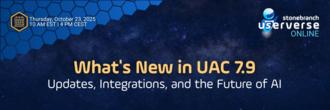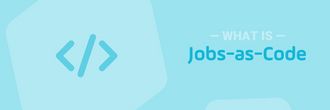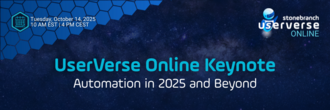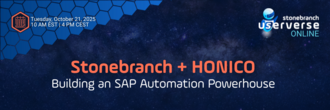Using Webhook Integrations for Event-Driven Automation
Need to share real-time data updates from one application to another? Webhooks are a fast and easy way to enable event-driven automation.
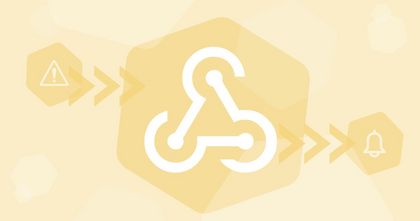
As we operate in an increasingly diverse set of systems and technologies, it’s becoming more important to share information across them all. To accomplish this, you could develop an API (application programming interface) integration to open two-way communications between your systems. But when all you need is a real-time update, webhooks are the way to go.
Low-code and high-speed, webhooks simplify event-driven automation to just the basics: when a specific event happens in one system, the webhook sends an automated call to another. That’s it.
No need to waste time and money on API development.
No need to rely on legacy polling methods.
No need for any advanced technical skills.
Keep scrolling to learn more. You’ll also find a short video of Stonebranch CTO Peter Baljet discussing how Stonebranch uses webhooks to enable event-driven automations in the Universal Automation Center (UAC).
What is a Webhook?
Webhooks are event-driven, one-way messages sent from one system to another. They use a push approach: every time a specified event takes place, the webhook immediately posts a JSON payload to a specified URL. You (or UAC) can then use the provided data to trigger additional workflows.
Webhooks are an efficient, cost-effective alternative to APIs and legacy polling techniques.
API vs Webhook: What’s the Difference?
APIs establish a connection for two-way communication between applications or systems. They enable data sharing, file transfers, and cross-application automations. They’re a powerful way to extend the features and functionality of your IT investments, while breaking down data silos along the way.
REST APIs have become the most popular kind of API. And it’s no wonder — they’re based on standard web technologies. They also offer developers significant flexibility in how they’re used. However, REST APIs pose a few challenges:
- Specific parameters required. For a REST API to work, it requires specific parameters that must be passed in and configured by the calling system.
- Constant, costly polling. APIs can be used to repeatedly call the server to check for any updates. Each call made has a cost, and those costs can add up quickly over time — especially for frequent polling.
- Long lead times for API development. While functional flexibility is a benefit of REST APIs, this flexibility can also cause long, costly development cycle times before the interface can be put into use.
Like REST APIs, webhooks use HTTP as a transport mechanism. Unlike REST, the webhook HTTP is a simple URL request that sends a structured payload, typically in JSON, providing context data that the calling system can use to take an action. Because the calling system only needs to know the URL endpoint, integrations are configured rapidly.
How do Webhooks Work?
Curious to see an example of webhooks in action? Check out this four-minute walkthrough of a webhook-enabled flow by Stonebranch CTO Peter Baljet.
As you can see in this example, an automation platform like the UAC uses webhooks to centrally orchestrate event-based tasks across multiple cloud systems and user applications, such as:
- Azure blob storage gets a new file: when a file enters Azure blob storage, a “blob-created” webhook notifies UAC.
- UAC triggers Inter-Cloud File Transfer: when UAC receives the notification, it uses its advanced filtering capabilities to determine the next step. In this case, it’s a managed file transfer (MFT) to AWS S3 for staging.
- AWS S3 completes file transfer: once the file is fully transferred to S3, an “object-created” webhook notifies UAC.
- UAC sends data to AWS Redshift: upon receiving the notification and applying the appropriate next-step filters, UAC loads the data to Redshift to update analytics data.
- AWS Redshift loads the data: after fully loading the data into Redshift, a “data-loaded” webhook notifies UAC (and any other interested subscribers).
- UAC sends notification(s) via Microsoft Teams: UAC sends notifications to interested end-users that new data is available for analysis, if they’d like to take a look.
This example follows one specific flow of data, but it’s important to note that each webhook event can trigger a variety of tasks across multiple flows.
Connect to Anything in Your Hybrid IT Environment
Stonebranch offers a variety of ways to connect to anything across your hybrid IT environment.
- The Stonebranch Integration Hub offers downloadable pre-built integrations for popular applications and cloud service providers to help automate IT service management, data pipelines, infrastructure, DevOps, and more.
- The Universal Integration Platform for Visual Studio allows developers to quickly build, prototype, and upload custom extensions.
- Webhook capabilities enable event-driven automation that spans a variety of cloud-based systems and applications.
- Universal agents automate tasks for containers and on-premises technologies, and bridge the gap to orchestrate in synchrony with cloud processes.
With the advent of Universal Events in UAC version 7.2 and webhooks in 7.3, Stonebranch is making a conscious move away from polling-based automation toward event-based orchestration. Would you like to learn more? Contact us to schedule a demonstration.
Start Your Automation Initiative Now
Schedule a Live Demo with a Stonebranch Solution Expert


